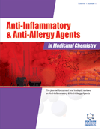- Home
- A-Z Publications
- Anti-Inflammatory & Anti-Allergy Agents in Medicinal Chemistry (Formerly Current Medicinal Chemistry - Anti-Inflammatory and Anti-Allergy Agents)
- Previous Issues
- Volume 8, Issue 3, 2009
Anti-Inflammatory & Anti-Allergy Agents in Medicinal Chemistry (Formerly Current Medicinal Chemistry - Anti-Inflammatory and Anti-Allergy Agents) - Volume 8, Issue 3, 2009
Volume 8, Issue 3, 2009
-
-
Editorial [Hot topic: Microbiota, Innate Immune and Anti-Inflammation (Guest Editor: Jun Sun)]
More LessBy Jun SunWelcome to the 2009 Anti-Inflammatory & Anti-Allergy Agents in Medicinal Chemistry (HOT TOPIC) Vol. 8, No. 3. The theme we have chosen for this volume is Microbiota, innate immune, and anti-inflammation. We attempt to highlight the current state-of-the-art relevant to innate immunity regulation and inflammation, functions of the anti-inflammatory bacterial proteins, application of the probiotics in digestive diseases, an Read More
-
-
-
Vascular Inflammation During Human Rickettsioses: An Essential Host Response and a Potential Target for Supplemental Therapy
More LessSpotted fever rickettsioses due to Rickettsia rickettsii and R. conorii and epidemic typhus caused by R. prowazekii have been known to humankind since the beginning of the 20th century. Alarmingly, new species/subspecies of arthropod-borne rickettsiae are still being recognized and described as globally emerging pathogens. The genus Rickettsia includes obligate intracellular α-proteobacteria with affinity to infect vascular end Read More
-
-
-
Pathogenic Bacterial Proteins and their Anti-Inflammatory Effects in the Eukaryotic Host
More LessBy Jun SunBacteria use multiple strategies to bypass the inflammatory responses in order to survive in the host cells. In this review, we discuss the mechanism of the bacerial proteins in inhibiting inflammation. We highlight the antiinflammatory roles of the type three secretion proteins including Salmonella AvrA, Enteropathogenic Escherichia coli Cif, and Yersinia YopJ, Staphylococcus aureus extracellular adherence protein, and Chlamydia pr Read More
-
-
-
Innate Immunity and Microbes: Conversations with the Gut Leading to Intestinal Tissue Repair and Fibrosis
More LessAuthors: Deanna L. Gibson, Marinieve Montero, Natasha R. Ryz and Bruce A. VallanceInflammatory bowel diseases (IBD) are thought to occur because of impaired mucosal integrity that allows enteric bacteria to leak out of the intestine, triggering maladaptive intestinal inflammation. While the exact pathogenesis of IBD is unclear, studies have recently demonstrated that bacterial activation of innate receptors not only causes inflammation, but may also play an important role in modulating intestinal epithe Read More
-
-
-
Neonatal Necrotizing Enterocolitis -Inflammation and Intestinal Immaturity
More LessNeonatal necrotizing enterocolitis is a devastating inflammatory bowel disease of premature infants. The pathogenesis remains incompletely understood and there is no specific treatment. Efforts are ongoing to understand aspects of intestinal immaturity which contribute to susceptibility to this disease. This review focuses on bacterial colonization patterns, intestinal barrier function, and inflammatory responses of immatu Read More
-
-
-
Probiotics and Gastrointestinal Disease: Clinical Evidence and Basic Science
More LessOur intestinal microbiota serve many roles vital to the normal daily function of the human gastrointestinal tract. Many probiotics are derived from our intestinal bacteria, and have been shown to provide clinical benefit in a variety of gastrointestinal conditions. Current evidence indicates that probiotic effects are strain-specific, they do not act through the same mechanisms, and nor are all probiotics indicated for the same hea Read More
-
-
-
Evolution of Novel Non-Steroidal Anti-Inflammatory Drugs with Reduced Gastrointestinal Adverse Effects
More LessAuthors: Umid K. Shrestha, Rakesh Kumar Jha and Bing XiaNon-steroidal anti-inflammatory drugs (NSAIDs) are widely used to relieve pain and symptoms of arthritis and soft tissue inflammation. The gastrointestinal (GI) adverse effects such as gastric and duodenal ulcers and their complications are the major limitations to the prescription of these drugs. As many as 25% of chronic NSAID users develop peptic ulcer disease among which 2%-4% bleed or perforate. Hence, the e Read More
-
Volumes & issues
-
Volume 24 (2025)
-
Volume 23 (2024)
-
Volume 22 (2023)
-
Volume 21 (2022)
-
Volume 20 (2021)
-
Volume 19 (2020)
-
Volume 18 (2019)
-
Volume 17 (2018)
-
Volume 16 (2017)
-
Volume 15 (2016)
-
Volume 14 (2015)
-
Volume 13 (2014)
-
Volume 12 (2013)
-
Volume 11 (2012)
-
Volume 10 (2011)
-
Volume 9 (2010)
-
Volume 8 (2009)
-
Volume 7 (2008)
-
Volume 6 (2007)
-
Volume 5 (2006)
Most Read This Month
Article
content/journals/aiaamc
Journal
10
5
false
en


